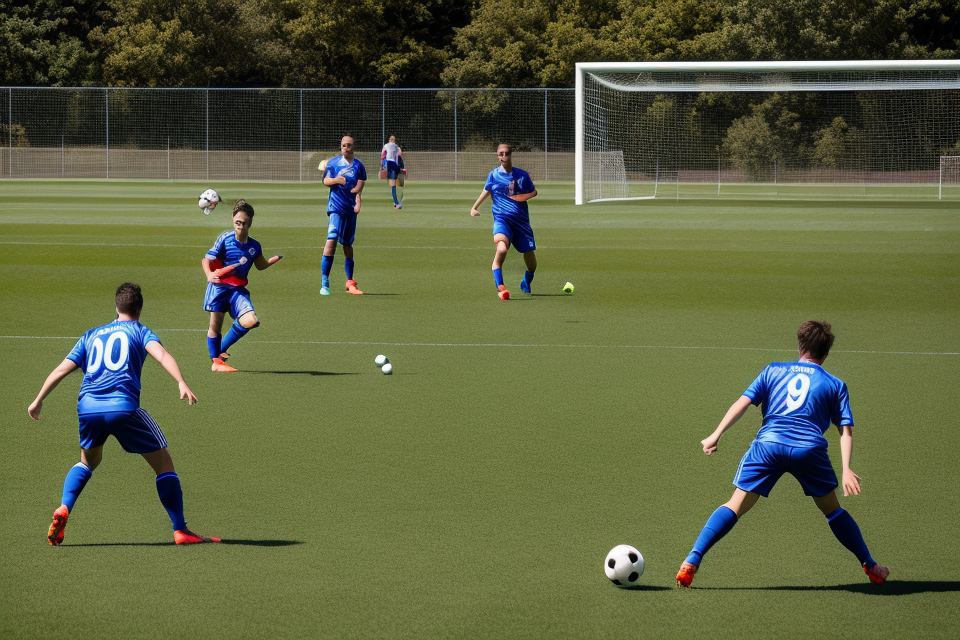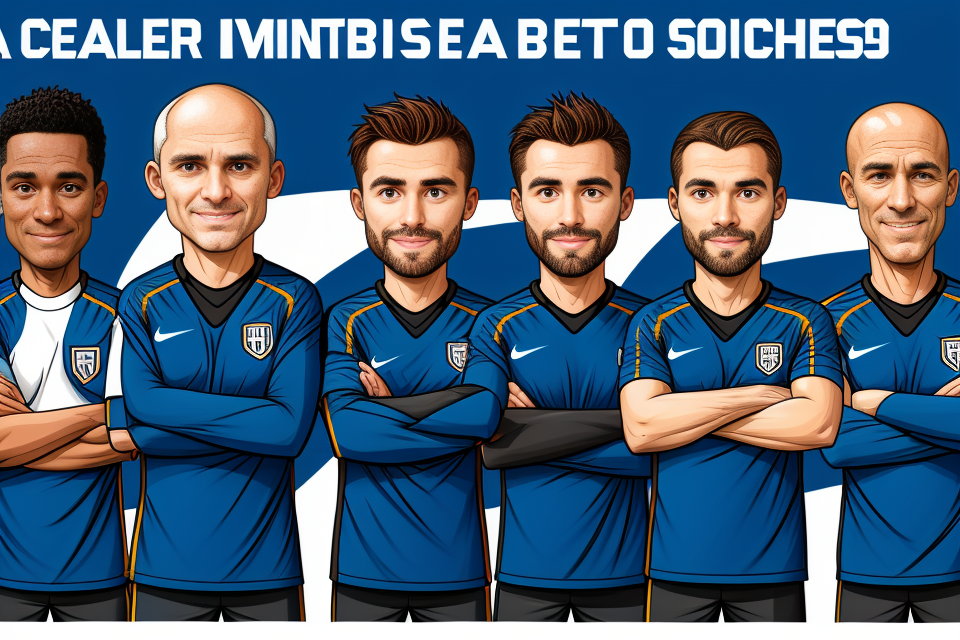Coaching a soccer player can be a challenging yet rewarding experience. Whether you’re working with a team of young players or guiding a seasoned pro, the goal is always the same: to help them reach their full potential on the field. In this article, we’ll explore some effective strategies for coaching soccer players, including tips and techniques that can help you build a winning team. From developing individual skills to fostering teamwork and communication, we’ll cover everything you need to know to be a successful soccer coach. So, whether you’re a seasoned pro or just starting out, read on to discover how to coach a soccer player like a champion.
Establishing a Positive Coaching Environment
Fostering a Positive Relationship with Players
- Building Trust and Rapport
- Understanding Player Perspectives
- Communicating Effectively
Building Trust and Rapport
A coach’s ability to build trust and rapport with their players is crucial for creating a positive coaching environment. This involves fostering an atmosphere of mutual respect, open communication, and understanding.
One effective strategy for building trust and rapport is to create opportunities for players to get to know you as a coach and for you to get to know them as individuals. This can involve having regular one-on-one meetings with players, encouraging open communication during team meetings, and participating in team-building activities outside of soccer training.
Another important aspect of building trust and rapport is to be consistent in your approach and behavior. This means treating all players fairly and with respect, regardless of their skill level or position on the field. By demonstrating consistency and fairness, you can establish yourself as a reliable and trustworthy coach who values each player’s contributions to the team.
Understanding Player Perspectives
Understanding player perspectives is another key component of fostering a positive relationship with players. This involves taking the time to listen to players’ concerns, goals, and feedback, and using this information to inform your coaching approach.
One effective strategy for understanding player perspectives is to regularly ask for feedback from players, both individually and as a group. This can involve asking for their input on training sessions, games, and team dynamics, and using this feedback to make adjustments to your coaching approach as needed.
By taking the time to understand player perspectives, you can build a stronger sense of trust and rapport with your players, and create a coaching environment that is responsive to their needs and goals.
Communicating Effectively
Effective communication is also essential for fostering a positive relationship with players. This involves using clear, concise language, actively listening to players, and providing constructive feedback that is focused on player development rather than criticism.
One effective strategy for communicating effectively is to use “I” statements when providing feedback, rather than “you” statements. For example, instead of saying “you didn’t pass the ball well,” you could say “I noticed that the passing wasn’t quite working today, let’s work on some drills to improve it.”
By using this approach, you can help players feel more comfortable and open to feedback, and create a coaching environment that is focused on player development rather than criticism.
Creating a Supportive Team Culture
Creating a supportive team culture is crucial for the success of any soccer team. Here are some tips for fostering a positive team environment:
- Encouraging Teamwork and Collaboration
- Encourage players to work together and support each other on the field.
- Create team-building exercises and activities to promote trust and camaraderie among players.
- Reinforce the importance of passing and communication on the field.
- Celebrating Successes and Learning from Failures
- Celebrate successes and achievements, both big and small, to boost morale and build confidence.
- Use setbacks and failures as opportunities for learning and growth.
- Emphasize the importance of resilience and perseverance in achieving long-term success.
- Developing a Shared Vision and Goals
- Create a shared vision for the team, outlining what they hope to achieve together.
- Establish clear goals and objectives for each game and season.
- Encourage players to take ownership of their goals and work towards them as a team.
Building Technical Skills and Tactical Knowledge
Technical Skills Development
- Ball Control and Dribbling
- The ability to control the ball with different parts of the body is crucial for a soccer player. Coaches should focus on developing players’ close control, using various surfaces of the feet, thighs, and chest to control the ball.
- Dribbling is the ability to move with the ball while maintaining control. Coaches should work on dribbling techniques such as the step-over, fake, and feint moves to help players change direction and gain space.
- Passing and Receiving
- Passing is a fundamental skill in soccer, and coaches should focus on teaching players to pass accurately and with the right pace. Players should be encouraged to use different types of passes, such as short, long, and diagonal passes, depending on the situation.
- Receiving is the ability to control the ball after it has been passed. Coaches should work on techniques such as trapping, controlling with different parts of the body, and bringing the ball down with the chest or thighs.
- Shooting and Scoring
- Shooting is the ability to score goals, and coaches should focus on developing players’ shooting technique. Players should be encouraged to use different types of shots, such as the inside, outside, and laces of the foot, depending on the situation.
- Scoring is the ability to find the back of the net. Coaches should work on techniques such as shooting into the corners, volleys, and headers, and encourage players to practice finishing in different situations.
Tactical Knowledge and Game Awareness
Tactical knowledge and game awareness are crucial components of a soccer player’s development. A player’s ability to read the game, make informed decisions, and adapt to different situations and opponents can significantly impact the team’s overall performance. As a coach, it is essential to focus on developing these skills in your players to help them become well-rounded and effective soccer players.
Formations and Positioning
One aspect of tactical knowledge is understanding different formations and positioning. As a coach, it is important to teach your players the different positions on the field and how they work together to create a cohesive unit. Players should understand their role within the team and how to position themselves to support their teammates and defend against the opposition.
Reading the Game and Making Decisions
Another key aspect of tactical knowledge is the ability to read the game and make informed decisions. This involves understanding the flow of the game, recognizing opportunities to attack or defend, and anticipating the movements of teammates and opponents. Coaches can help players develop this skill by providing them with opportunities to watch and analyze games, as well as through small-sided games and drills that simulate different game scenarios.
Adapting to Different Situations and Opponents
Soccer games can be unpredictable, and players must be able to adapt to different situations and opponents. This involves understanding the strengths and weaknesses of both teammates and opponents and adjusting the team’s tactics accordingly. Coaches can help players develop this skill by exposing them to a variety of game situations and opponents, both in training and in real matches. Players should also be encouraged to think critically and make decisions based on the changing circumstances of the game.
In summary, tactical knowledge and game awareness are critical components of a soccer player’s development. By focusing on these skills, coaches can help their players become well-rounded and effective soccer players who can make informed decisions and adapt to different situations on the field.
Developing Mental and Emotional Resilience
Mental Preparation and Focus
Visualization and Imagery
Visualization and imagery are powerful mental techniques that can help soccer players prepare for games and perform at their best. By mentally rehearsing specific scenarios, such as taking a penalty kick or making a crucial tackle, players can build confidence and reduce anxiety. Visualization can also help players to stay focused and calm during games, enabling them to make quick decisions and react to unexpected situations.
Goal Setting and Motivation
Setting clear and achievable goals is an important aspect of mental preparation for soccer players. Goals provide a sense of direction and purpose, and help players to stay motivated and focused throughout the season. Coaches can work with players to set both short-term and long-term goals, and can provide support and guidance to help players achieve these goals.
Managing Pressure and Anxiety
Soccer games can be high-pressure situations, and players may experience anxiety and stress before and during games. Coaches can help players to manage these feelings by teaching relaxation techniques, such as deep breathing and progressive muscle relaxation. Coaches can also encourage players to focus on the present moment, rather than worrying about the past or future, and can help players to develop a positive mindset and self-belief.
Emotional Intelligence and Self-Awareness
Emotional intelligence is a crucial aspect of developing mental and emotional resilience in soccer players. It refers to the ability to recognize, understand, and manage one’s own emotions, as well as the emotions of others. Here are some key elements of emotional intelligence and self-awareness that coaches can incorporate into their training programs:
- Recognizing and Managing Emotions: Soccer players are often faced with high-pressure situations on the field, and it’s important for them to be able to recognize and manage their emotions in these moments. This includes understanding how to stay calm under pressure, how to respond to criticism or failure, and how to motivate oneself and others. Coaches can help players develop these skills by providing opportunities for them to practice in simulated game situations, as well as through team-building exercises and communication drills.
- Empathy and Understanding Others: In addition to managing their own emotions, soccer players must also be able to understand and empathize with their teammates and opponents. This includes recognizing and respecting the diversity of personalities and cultures within the team, as well as understanding the motivations and perspectives of other players on the field. Coaches can encourage empathy and understanding by creating opportunities for players to interact with each other in a supportive and inclusive environment, and by emphasizing the importance of teamwork and collaboration.
- Communicating Effectively Under Pressure: Communication is a key aspect of soccer, and players must be able to communicate effectively with their teammates and coaches in high-pressure situations. This includes being able to give and receive feedback, as well as to adapt to changing circumstances on the field. Coaches can help players develop these skills by providing opportunities for them to practice communication in simulated game situations, as well as through role-playing exercises and feedback sessions.
By incorporating these elements of emotional intelligence and self-awareness into their training programs, coaches can help soccer players develop the mental and emotional resilience they need to succeed on the field.
Fostering Physical Conditioning and Injury Prevention
Physical Conditioning and Training Programs
To achieve optimal performance on the soccer field, it is essential to implement comprehensive physical conditioning and training programs that focus on improving both endurance and strength.
Aerobic and Anaerobic Conditioning
Aerobic and anaerobic conditioning are critical components of a soccer player’s training regimen. Aerobic conditioning helps improve cardiovascular endurance, which is necessary for sustained play throughout the game. Anaerobic conditioning, on the other hand, involves high-intensity exercises that help develop explosiveness and power, essential for sprinting, tackling, and shooting.
Strength and Conditioning Exercises
Strength and conditioning exercises should be tailored to the specific needs of soccer players. For instance, exercises that target the legs, core, and upper body are crucial for improving power, stability, and overall performance. Resistance training, plyometrics, and agility drills are all effective exercises that can be incorporated into a soccer player’s training program.
Flexibility and Mobility Training
Flexibility and mobility training are also vital for preventing injuries and optimizing performance. Soccer players should engage in regular stretching and mobility exercises to improve their range of motion, reduce the risk of muscle strains and tears, and enhance their ability to change direction quickly.
Overall, a well-rounded physical conditioning and training program should include a combination of aerobic and anaerobic exercises, strength and conditioning exercises, and flexibility and mobility training. By incorporating these elements into their training regimen, soccer players can improve their endurance, power, and overall performance on the field.
Injury Prevention and Safety
- Warm-up and Cool-down Techniques
- Proper Technique and Form
- Recognizing and Addressing Signs of Injury
Warm-up and Cool-down Techniques
Before beginning any soccer training session, it is essential to properly warm up the body. This can be achieved through a variety of exercises, such as jogging, stretching, and light aerobic activity. The warm-up should last between 10-15 minutes and should gradually increase the heart rate to prepare the body for physical activity.
Similarly, after the training session, it is crucial to cool down the body to prevent injury and promote recovery. This can be done through gentle stretching and flexibility exercises, which will help to reduce muscle soreness and improve flexibility. The cool-down period should last at least 5-10 minutes and should be done gradually to prevent a sudden drop in heart rate.
Proper Technique and Form
Correct technique and form are essential in preventing injury in soccer players. Coaches should emphasize the importance of proper technique in all aspects of the game, including dribbling, passing, shooting, and tackling. Players should be taught to use their legs, feet, and body in the correct positions and movements to prevent injury and maximize performance.
Additionally, coaches should monitor players’ form during training and games to ensure that they are not putting themselves at risk of injury. Players who demonstrate incorrect technique or form should be given feedback and guidance on how to improve.
Recognizing and Addressing Signs of Injury
It is important for coaches to be able to recognize the signs of injury in soccer players. Common signs of injury include pain, swelling, bruising, and difficulty moving or performing certain movements. Coaches should encourage players to report any discomfort or pain they experience during training or games.
If a player is injured, coaches should provide immediate medical attention and follow the appropriate protocol for injury management. Players who are injured should be given time to rest and recover, and coaches should provide them with rehabilitation exercises to aid in their recovery. It is also important for coaches to provide psychological support to injured players to help them cope with the emotional impact of injury.
Integrating Technology and Analytics into Coaching
Utilizing Technology for Performance Analysis
Performance analysis is a crucial aspect of coaching soccer players. With the help of technology, coaches can analyze their players’ performance in detail and identify areas that need improvement. Here are some ways in which technology can be utilized for performance analysis:
Video Analysis and Match Review
Video analysis is a popular method used by coaches to review matches and analyze the performance of their players. By recording the matches, coaches can go through the footage multiple times to identify key moments, analyze the players’ movements, and assess their overall performance. Video analysis can help coaches identify patterns and tendencies in their players’ game, which can be used to improve their overall performance.
Performance Tracking and Data Analysis
Performance tracking involves collecting data on various aspects of the game, such as possession, passes, shots, and tackles. With the help of software, coaches can track these metrics and analyze the data to identify patterns and trends in their players’ performance. This data can be used to evaluate the players’ performance, identify areas for improvement, and set individual and team goals.
Player Feedback and Development
Technology can also be used to provide players with feedback on their performance. By using software that analyzes player movements and performance, coaches can provide players with detailed feedback on their movements, technique, and decision-making. This feedback can help players improve their performance and develop their skills over time. Additionally, technology can be used to create personalized training programs for each player, based on their strengths and weaknesses.
Overall, utilizing technology for performance analysis can provide coaches with valuable insights into their players’ performance, help them identify areas for improvement, and develop effective strategies for coaching soccer players.
Applying Analytics for Tactical Decision-making
Understanding Advanced Statistics and Metrics
One of the key components of applying analytics for tactical decision-making in soccer is understanding advanced statistics and metrics. This includes data such as expected goals (xG), expected assists (xA), and expected possession (xP). These metrics can provide valuable insights into a team’s performance and help coaches make informed decisions about tactics and strategies.
Using Data to Inform Tactics and Strategies
Another important aspect of applying analytics for tactical decision-making is using data to inform tactics and strategies. This can involve analyzing data on possession, passing, and shots to identify areas where the team can improve. Additionally, coaches can use data to identify the team’s strengths and weaknesses, and to make adjustments to the team’s tactics and strategies accordingly.
Adapting to Opponents and Game Situations
Finally, coaches can use analytics to adapt to opponents and game situations. This can involve analyzing data on the opposition’s tactics and strategies, as well as data on the team’s own performance against specific opponents. By understanding an opponent’s strengths and weaknesses, coaches can make tactical adjustments to neutralize their opponent’s threats and exploit their weaknesses.
Continuous Learning and Professional Development
Staying Current with Coaching Best Practices
- Attending Workshops, Conferences, and Courses
- Networking with Other Coaches and Professionals
- Reading Books, Articles, and Research Studies
Attending Workshops, Conferences, and Courses
Attending workshops, conferences, and courses is an excellent way to stay current with coaching best practices. These events provide opportunities to learn from experienced coaches, network with other professionals, and discover new training techniques and strategies.
Some benefits of attending these events include:
- Gaining insight into the latest coaching trends and techniques
- Networking with other coaches and professionals in the field
- Developing new skills and strategies to improve player performance
- Hearing from expert speakers and learning from their experiences
To make the most of these events, it’s essential to choose those that align with your coaching goals and preferences. Consider attending workshops and conferences that focus on specific aspects of soccer coaching, such as player development, tactics, or fitness training. Additionally, look for events that offer hands-on training and practical exercises to help you apply new techniques in your coaching practice.
Networking with Other Coaches and Professionals
Networking with other coaches and professionals is an invaluable way to stay current with coaching best practices. Building relationships with other coaches can provide opportunities to share ideas, learn from each other’s experiences, and collaborate on new training techniques.
Some ways to network with other coaches include:
- Joining coaching associations or organizations
- Participating in online forums or social media groups for coaches
- Attending coaching events and conferences
- Reaching out to other coaches directly to discuss coaching techniques and strategies
By building relationships with other coaches, you can expand your knowledge of soccer coaching and discover new ways to improve player performance.
Reading Books, Articles, and Research Studies
Reading books, articles, and research studies is an excellent way to stay current with coaching best practices. These resources provide valuable insights into the latest coaching trends, techniques, and strategies.
Some benefits of reading these resources include:
- Gaining a deeper understanding of soccer coaching principles and techniques
- Learning from experts in the field and their experiences
- Discovering new training methods and strategies to improve player performance
- Staying up-to-date on the latest research and developments in soccer coaching
To make the most of these resources, it’s essential to choose those that align with your coaching goals and preferences. Look for books and articles written by experienced coaches and experts in the field, and consider reading research studies that provide evidence-based insights into soccer coaching. Additionally, be sure to stay open-minded and willing to try new techniques and strategies to improve your coaching practice.
Growing as a Coach and Leader
- Developing New Skills and Expertise
- Expanding your knowledge in sports psychology, strength and conditioning, and injury prevention can help you become a more well-rounded coach.
- Pursuing specialized certifications or advanced degrees can demonstrate your commitment to the profession and enhance your credibility.
- Mentoring and Supporting Other Coaches
- Sharing your expertise and experience with other coaches can help them develop their skills and improve their performance.
- Offering guidance and support to other coaches can also foster a sense of community and collaboration within the coaching profession.
- Expanding Your Network and Professional Relationships
- Attending conferences, workshops, and other events can provide opportunities to connect with other coaches, industry experts, and thought leaders.
- Building a strong network of professional relationships can provide valuable resources, support, and guidance as you continue to grow and develop as a coach.
FAQs
1. What are the key principles of coaching soccer players?
The key principles of coaching soccer players include creating a positive learning environment, developing individual player skills, fostering teamwork and communication, promoting physical and mental development, and implementing effective training methods. A coach should also prioritize player safety and well-being, and ensure that they are creating a supportive and inclusive team culture.
2. How can I create a effective training program for soccer players?
Creating an effective training program for soccer players involves a combination of technical, tactical, physical, and mental training. It’s important to develop a comprehensive training plan that takes into account the player’s individual needs and goals, as well as their current level of skill and fitness. The training program should also be regularly evaluated and adjusted to ensure that it is meeting the needs of the players and helping them to reach their full potential.
3. How can I help my players improve their technical skills?
To help your players improve their technical skills, you can focus on specific drills and exercises that target the areas they need to work on. This might include dribbling, passing, shooting, and ball control. It’s important to provide clear instructions and feedback, and to encourage players to practice regularly outside of training sessions. You can also use video analysis to help players understand their technique and identify areas for improvement.
4. How can I help my players improve their tactical awareness?
To help your players improve their tactical awareness, you can use a variety of exercises and drills that focus on different aspects of the game, such as positioning, movement off the ball, and teamwork. You can also use small-sided games and scrimmages to simulate match conditions and help players learn how to make tactical decisions on the field. It’s important to provide clear instructions and feedback, and to encourage players to think critically about their actions and decisions.
5. How can I help my players improve their physical fitness?
To help your players improve their physical fitness, you can incorporate a variety of exercises and drills that target different aspects of fitness, such as endurance, strength, and agility. You can also use interval training and other high-intensity exercises to challenge players and improve their cardiovascular fitness. It’s important to provide clear instructions and feedback, and to monitor players’ progress over time to ensure that they are making steady improvements.
6. How can I help my players develop mental toughness?
To help your players develop mental toughness, you can incorporate a variety of exercises and drills that focus on mental skills such as concentration, confidence, and resilience. You can also use visualization techniques and other mindfulness practices to help players develop a positive mindset and stay focused under pressure. It’s important to provide clear instructions and feedback, and to encourage players to reflect on their experiences and learn from their mistakes.



